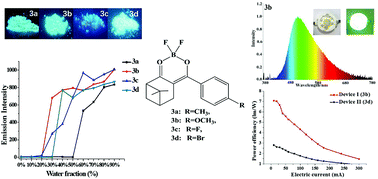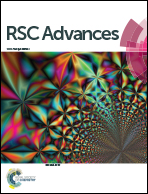Nopinone-based aggregation-induced emission (AIE)-active difluoroboron β-diketonate complex: photophysical, electrochemical and electroluminescence properties†
Abstract
Four difluoroboron (BF2) β-diketonate nopinone complexes 3a–3d that exhibited typical aggregation-induced emission (AIE) properties were synthesized using the natural renewable β-pinene derivative nopinone as the starting material. The thermal, photophysical, electrochemical and electroluminescent properties as well as the AIE properties of complexes 3a–3d were analyzed systematically. The data of photophysical and electrochemical demonstrated that compound 3b with a methoxy group exhibited the largest bathochromic shift, the highest absolute photoluminescence quantum yields and narrowest optical bandgap among 3a–3d. Using 3b as the emitter, electroluminescent (EL) device I exhibits blue-green light with CIE coordinates of (0.2774, 0.4531) and showed a better performance with a luminous efficacy (ηp) of 7.09 lm W−1 and correlated color temperature (TC) of 7028 K. The results demonstrate that new AIE compounds are promising solid-state luminescent materials with practical utility in electroluminescent materials.

- This article is part of the themed collection: Editors’ collection: Fluorescent Sensors


 Please wait while we load your content...
Please wait while we load your content...